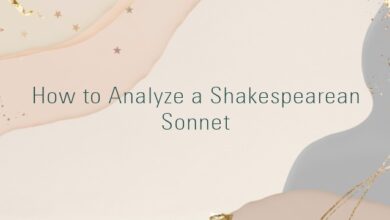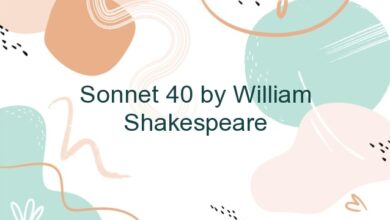
No more be grieved atthat which thou hast done:
Roses have thorns, and silver fountains mud:
Clouds and eclipses stain both moon and sun,
And loathsome canker lives in sweetest bud.
All men make faults, and even I in this,
Authorizing thy trespass with compare,
Myself corrupting, salving thy amiss,
Excusing thy sins more than thy sins are;
For to thy sensual fault I bring in sense,
Thy adverse party is thy advocate,
And ‘gainst myself a lawful plea commence:
Such civil war is in my love and hate,
That I an accessary needs must be,
To that sweet thief which sourly robs from me.
This continues the theme of the previous two sonnets. The sin which the youth has committed against the poet, which previously appeared to be a denial of love, or a denial of commitment, here is described also as ‘a sensual fault’, which implies some sin of the flesh, lust for another person perhaps, or merely a temporary lapse from grace. We cannot know the details of the ‘amiss’, since no other clues are given us, but it is possible that the fault is linked to that which is described in 40-42, in which the youth is reproached for stealing the poet’s mistress. For the denial of love which the previous two sonnets imply could hardly be described as ‘a sensual fault’, but perhaps that denial is here merged with the later sin of poaching a lover. It is unlikely that we will ever have the necessary information to know what the poet was referring to as the beloved’s amiss and we must be satisfied with whatever our imaginations can conjure up.
The sestet of the sonnet introduces legal terminology, a break from the biblical and theological language of sin and redemption which dominates the previous sonnet, and here lines 5-8.
The 1609 Quarto Version
NO more bee greeu’d at that which thou haſt done,
Roſes haue thornes,and ſiluer fountaines mud,
Cloudes and eclipſes ſtaine both Moone and Sunne,
And loathſome canker liues in ſweeteſt bud.
All men make faults,and euen I in this,
Authorizing thy treſpas with compare,
My ſelfe corrupting ſaluing thy amiſſe,
Excuſing their ſins more then their ſins are:
For to thy ſenſuall fault I bring in ſence,
Thy aduerſe party is thy Aduocate,
And gainſt my ſelfe a lawfull plea commence,
Such ciuill war is in my loue and hate,
That I an acceſſary needs muſt be,
To that ſweet theefe which ſourely robs from me,
Commentary
1. No more be grieved atthat which thou hast done:No more be grieved at = Do not feel any further sorrow because of;
that which thou hast done – either refers to the rejection of the lover in the previous two sonnets, or to the ‘trespass’ alluded to in this one, and perhaps also to the ‘robbery’ of 40-43.2. Roses have thorns, and silver fountains mud:This is a traditional list of the faults of beautiful things.’No rose without a thorn’ is proverbial.3. Clouds and eclipses stain both moon and sun,stain – this recalls Suns of the world may stain from 33. There was a belief that clouds and mists brought pollution and contagion. Eclipses were thought to be potentially even more dangerous, foretelling destruction to the high and mighty of the world.4. And loathsome canker lives in sweetest bud.canker = worm or disease which destroys flowers.
The canker galls the infants of the spring,
Too oft before their buttons be disclosed Ham.1.3.39-40.
This canker that eats up Love’s tender spring VA.656.5. All men make faults, and even I in this,make faults = commit sins, are prone to error. May allude to the doctrine of original sin, and the belief that human nature is inherently sinful.6. Authorizing thy trespass with compare,Authorizing – accented on the second syllable.
trespass = sin. As in the Lord’s Prayer – forgive us our trespasses.
with compare = by making comparison(s), as in lines 1-4, the comparisons being false, in that sin is an offence against God, and cannot be justified by reasoned argument. The point here made is that the poet himself is guilty of sin in ‘authorizing’ his friend’s trespass.7. Myself corrupting, salving thy amiss,Myself corrupting = sc. by commiting the sin of justifying your offence. salving thy amiss = softening, smoothing over your sin. We still use the phrase ‘to salve one’s conscience’. amiss = fault, sin. There are 40 occurrences of amiss in Shakespeare, and mostly the use of it is adjectival or adverbal, as e.g
For never anything can be amiss,
When simpleness and duty tender it. MND.5.1.82-3.
Only here and at 151.3 do we find it used as a noun, presumably based on the idea of ‘doing something amiss’.8. Excusing thy sins more than thy sins are;
Cappell emended Q’s their…..their to thy…..thy, and this has been accepted by most editors. KDJ uses these…..these. If we accept thy the meaning is that ‘I use such legerdemain in justifying your sins, that it would be sufficient to excuse sins of even greater magnitude’. GBE suggests the emendation of Excusing to Accusing and retaining their…..their. I have used the Capell emendation.9. For to thy sensual fault I bring in sense,In defence of your sensual sin I bring in reason (sense).
sensual fault = fault involving one of the five senses; fault of sensuality or lust.
bring in = introduce as a topic or argument, or witness. This is probably intended in a legal sense, in view of the legal terminology which follows. There is also a pun on incense, enhancing the idea of loving and uncritical worship of the young man.
sense = reason.10. Thy adverse party is thy advocate,Thy adverse party = your legal opponent; it refers both to reason (sense) in the line above, and to the poet himself, who has taken up the defence of the youth, though being himself the injured party.
advocate = one who pleads in a court of law, an attorney.11. And ‘gainst myself a lawful plea commence:a lawful plea commence = initiate an action at law (to plead that your cause is just).12. Such civil war is in my love and hate,I am at war with myself, both loving and hating you. The admission of hatred is surprising, indeed somewhat disturbing, given the previous assertions of love. This is the only occasion on which it is used to refer to the poet’s emotions, although by contrast the youth’s feelings towards him are often characterised as hatred, both for dramatic emphasis, and because it was traditional to describe the disdain of the beloved as hatred. Compare 90.1:
Then hate me when thou wilt, if ever now,
and 107.12:
But shoot not at me in your waken’d hate;13. That I an accessary needs must be,A continuation of the legal terminology. ‘I am compelled to become an accomplice’. Compare:
To both their deaths shalt thou be accessary. R3.I.2.192.
accessary – the modern spelling is ‘accessory’. The distinction of spelling used to be between the adjective and noun, a distinction now lost. (See OED.etym. under accessary).I give the Webster 1913 definition below.
accessary: (Law): One who, not being present, contributes as an assistant or instigator to the commission of an offense. Accessary before the fact: (Law): one who commands or counsels an offense, not being present at its commission. — Accessary after the fact, one who, after an offense, assists or shelters the offender, not being present at the commission of the offense.This word, as used in law, is spelt accessory by Blackstone and many others; but in this sense is spelt accessary by Bouvier, Burrill, Burns, Whishaw, Dane, and the Penny Cyclopedia; while in other senses it is spelt accessory. In recent text-books on criminal law the distinction is not preserved, the spelling being either accessary or accessory.
Q’s reading is accessary.
needs must be = am compelled to be.14. To that sweet thief which sourly robs from me.
which = who.
robs – this suggests the stealing of a lover, as in 40, 42, (or the lover who steals). On the other hand it might be used simply as the necessary adjunct of being a thief. Or perhaps the robbery is of reason and good sense, for the poet’s world has become topsy-turvy, and he enters a plea against himself.






